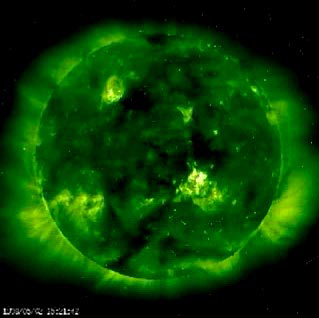Making Models
Scientists can learn a great deal about how the currents and magnetism on the Sun work as a system by studying models of the Sun's surface in their laboratories or in detailed computer calculations. Even though the difference in size between the Sun's diameter (6.5 x 1010 meters) and a lap top computer (0.3 meters) is enormous (about 2 x 1011 times), many physical laws can be scaled up or down in size so that even enormous solar flares can be investigated in human-sized models. Sometimes one group of sunspots collides with another like ships floating on the Sun's plasma ocean. Sometimes a brand new sunspot can appear inside one that was already there. If the magnetic polarities are the same, nothing much happens. But if they are opposite each other in some area of the Sun's surface, then this can only mean one thing: great energy is released as currents flow to annihilate some of the magnetic field (until a balance is achieved in which the field becomes simpler).

A
close up of a solar flare taken by the SOHO spacecraft. The
scale of the Earth is provided.
(Click
to launch movie) |
|
|
|
| |
Because sunspots and the gases around them can flow at thousands of kilometers
a minute, it only takes a few minutes before magnetic conditions can escalate
from a minor solar squall to a major explosion of energy. The billions of amperes
of current moving in opposite directions through the solar atmosphere release
over 1025 Joules of energy;
more energy than in a billion hydrogen bombs.
Powerful Currents
Within 20 minutes or less of a flare, the magnetic field of an active region changes into a simpler arrangement of energy. Meanwhile, gas has been heated to millions of degrees and a blast of X-rays leaves the scene of the event. In 9 minutes, the X-rays, traveling at 3 x 105 kilometers/second arrive at Earth, and cause short-wave blackouts across the entire daytime face of the planet. As the X-rays reach the daytime side of Earth, they cause major changes in the upper layers of the atmosphere, especially the ionosphere. The ionosphere is used in short-wave radio communications (which bounce transmitted signals off of its lower edge), and solar flare disturbances can disrupt radio communication for hours at a time. Any astronaut in space, or sensitive satellite electronics, can also be damaged by the extra intense x-rays from flares unless the proper precautions and shielding are used to reduce their risk.
Text adapted from the Sun-Earth Connection Tutorial courtesy
of NASA, originally written by
Dr. Sten Odenwald. Images and
videos courtesy of NASA unless otherwised noted.
Page 4 of 10 |
|
 |
|
 |
 |
Visit other pages in this section that focus on aspects of the Sun-Earth Connection.
|
|
 |
|
|




